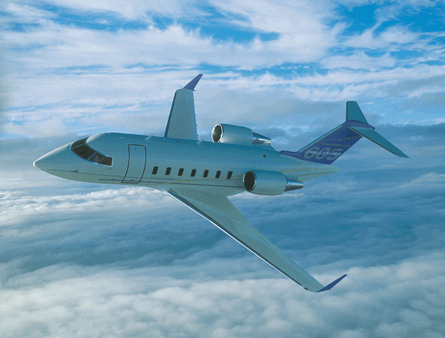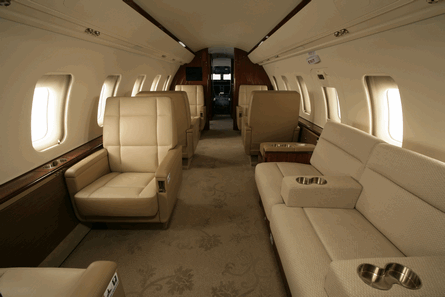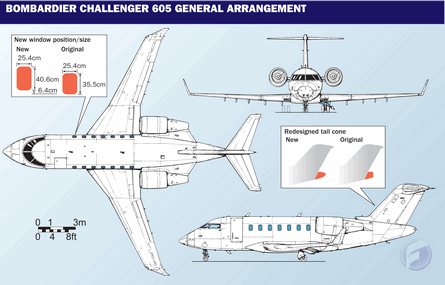The Challenger 605's cockpit has four side-by-side 15in portrait format displays - a 55% increase in display area compared with the 604
When Bombardier Aerospace decided to create the next generation of its venerable Challenger 600 series "large" category executive jet, most recently updated in 1995 with the certification of the Challenger 604, the to-do list was limited largely to avionics and cabin amenities.
 |
|---|
© Bombardier |
Why change a winning formula? Bombardier had already sold 710 Challenger 600s, 601s and 604s, amassing more than 3.5 million flight hours and an average dispatch reliability of 99.8%, giving the manufacturer a commanding lead over competing but newer large business jets such as the Dassault 2000DX, Embraer Legacy 600 and Gulfstream G350.
Rounded Tailcone
Bombardier did, however, want to set the new model apart from the other Challenger 600 series aircraft on the ramp, so engineers designed a tailcone that is rounded rather than square-tipped, differentiating the 605 from its predecessors while not affecting its flight performance positively or negatively.
Business aircraft-savvy planespotters will not be the only ones to notice a new Challenger on the ramp, however - pilots flying the $28.1 million Challenger 605 and passengers seated in its industry-leading cabin will find a wide range of improvements, from Rockwell Collins Pro Line 21 avionics in the front to high-speed data connectivity in the back. And upgrades will doubtless keep the aircraft's sales streak intact for years to come.
 |
|---|
© Bombardier |
Bombardier reports it has delivered 63 Challenger 605s as of 30 April (starting with serial number 5701), 18 months after certificating the aircraft in October 2006 and 15 months after first delivery in January 2007. The Montreal-based company does not report production rate or order status.
Most visible in the spacious 2.49m (8.2ft)-wide by 1.85m-tall stand-up cabin is the drastic increase in natural light compared with earlier models, an improvement that came from without and within. Bombardier raised the external height of each of the 15 cabin windows by 6.4cm (2.5in) and lengthened the height of the windows themselves from 36cm to 41cm, keeping the width set at 25.5cm.
On the inside, designers flared the "reveal" of the window, a change that when combined with the 14% larger window size, provides 30% more natural light in the interior and helps passengers better see the ground below without straining their neck muscles.
Metal Airframe
Bombardier assembles nearly 90% of the Challenger 605's metal airframe at its Dorval plant in Montreal, where it also completes the interiors for the Challenger and Global series business jets.
The fuselage, sans empennage, is built at the company's Ville St-Laurent plant, and the empennage is constructed at Bombardier's Short Brothers facility in Belfast, Northern Ireland. As with the Challenger 604, the 605 is powered by General Electric CF34-3 turbofan engines. It has triple-redundant hydraulic systems, quadruple-redundant electrical systems and doubly redundant environmental control systems.
Also unchanged is the 605's slatless, four-flap wing design, including the Bombardier-made winglets, anti-icing protection and stall warning protection systems. The wing features a "supercritical" aerofoil that reduces drag at the aircraft's Mach 0.82 cruise speed, yet behaves like a conventional aerofoil at lower speeds. A supercritical aerofoil has a large leading-edge radius and reduced upper surface camber compared with more traditional aerofoils, as well as a concave shape of the aft underside portion of the wing.
Departure Accident
The design came under scrutiny after a high-profile departure accident in Montrose, Colorado in November 2004, when a crew took off with "upper wing contamination", probably snow or ice, and crashed after a series of rapid left and right uncontrollable roll motions, according to a US National Transportation Safety Board final report.
Similar large roll rates occurred during a take-off stall accident involving a Challenger 600 series aircraft with contaminated wings in January 2002 at Birmingham airport, UK.
As part of the analysis into the cause of the Montrose accident, which claimed the lives of the captain, flight attendant and one of three passengers, Bombardier reported that windtunnel and flight testing had revealed that the presence of surface roughness "equivalent to 40-grit sandpaper" on the Challenger's wing could reduce the stall angle of attack by as much as 7° compared with the stall angle for an uncontaminated wing.
If a stall were to occur, "one wing typically stalls before the other once the natural stall angle of attack is exceeded, resulting in asymmetrical lift", says to the report, which adds: "Large roll rates and roll angles can then develop, depending upon pilot action."
Like other manufacturers, Bombardier met its certification requirements for the Challenger 600 series by incorporating a stall protection system which uses an AoA sensor that triggers a series of responses before natural aerodynamic stall occurs.
Initially, the system activates the engine auto-ignition. Then it triggers the stick shaker, and lastly it commands a stick-pusher and stick-pusher horn. Bombardier noted in the report that stall activation angles are a function of flap setting and altitude.
Airworthiness Directive
Despite the protection inherent in the design, Canadian and US authorities in 2005 issued an airworthiness directive for the Challenger 600 series that now requires visual and tactile tests of the wing surfaces for contamination during cold-weather operations. Wing leading edge anti-icing is provided by 14th stage bleed air from the engines.
Along with the wings, warranties are also largely the same between the old and new Challengers, with 10 years and 10,000h for the primary structure parts and labour, respectively, three years and 3,000h for systems and components, and five years and 2,500h for the engines. New for the Challenger 605 is a longer-lasting avionics warranty, up to five years for parts and labour from three years and four years, respectively. Bombardier says the mean time between failure for the new integrated avionics system is improved by 25%. Bombardier handles all warranty work except the engines, which are handled through GE.
In terms of interior layout, customers have four "executive" floorplan designs to choose from, ranging from a nine-passenger configuration with club seating, a three-person divan and lavatory, to an 11-passenger layout with an extended lavatory that doubles as a full-size changing room.
 |
|---|
© Bombardier |
The standard interior has seating for nine, club seating for four at the front of the cabin, with the divan and club seating for two in the back and wood fold-out tables. The divan folds out to make a bed, as do opposing leather seats in the club set-up.
In all configurations, headroom above the seats is 5cm greater because of redesigned, more streamlined passenger service units that house oxygen masks and reading lights. Cabin lighting is also more reliable, with the addition of single-colour LED upwash lighting at the top of the cabin, although Bombardier has not yet decided to convert the 605's external lights to LED technology, a move other manufacturers have made to increase bulb life and decrease maintenance.
As in other Challenger models, 3.25m2 (115ft2) of pressurised baggage area is accessible in flight through a door in the lavatory at the back of the cabin. Bombardier says the storage area can accommodate baggage for eight passengers - 24 pieces of luggage and eight golf bags "with room to spare".
Standard entertainment includes two 45.7cm bulkhead-mounted LCD monitors (one on the left forward bulkhead, one on the rear right bulkhead) wired to the digital Ethernet-based cabin electronics system (CES), as is an eight-speaker audio system and Iridium satellite communications package.
Touchscreen Control
There is a master touchscreen control for the cabin, as well as individual wired controls at each seat. The system can host optional 21in displays, DVD/CD players, Rockwell Collins Airshow with optional interactive control and network news, and a variety of personal electronics carry-on items such as iPods.
Also available as an option is the Inmarsat SwiftBroadband airborne office suite for high-speed data and voice service. Bombardier says some customers have ordered this option, although no aircraft have yet been delivered with the equipment. SwiftBroadband is available over the Americas, Africa, Europe and Asia, with two of three satellites now launched and operational. Inmarsat says the system will work globally "except in extreme polar regions" once its third satellite is launched, although no date has yet been set for the launch.
The galley has been redesigned, with input from customers and flight attendants. Bombardier says customers liked the Challenger 604 galley, which was laid out in a vertical "S" shape, but wanted more space. The new layout has two "towers" on the left and right sides and a bridgeless centre console with LED lighting and an 8.4in touchscreen CES control on the aft tower. Bombardier says it had initially placed the CES control on the forward tower, but flight attendants reviewing the design pointed out that mounting it on the aft tower would allow them to view the passenger cabin while making adjustments to environmental, lighting, entertainment, telecommunications and water systems.
Integrated Avionics
The 605's cockpit represents a leap in technological advances over that of the Challenger 604, with the addition of a Rockwell Collins Pro Line 21 integrated avionics system. With four side-by-side 15in portrait format displays, the cockpit offers a 55% increase in display area compared with the 604's array of six 8.4in CRTs as part of the Pro Line 4 package. In 2002, Rockwell Collins offered a Pro Line 21 retrofit option for the 604, with 13in displays and conventional "round dial" representations of the flight instruments.
Standard with the Pro Line 21's primary flight display is a flightpath vector with trajectory information similar to that provided by a head-up display. Below the attitude information is an electronic compass that can be overlaid with optional weather from XM for the USA or Universal Weather for international routes, terrain from the terrain awareness and warning system (TAWS) and air traffic targets from the traffic alert and collision avoidance system (TCAS). Multifunction displays are nominally configured to show engine indication and crew alerting system (EICAS) at the top and synoptic data, including aircraft configuration diagrams, below. The lower display can be used for flight planning and other options. Two flight management system control panels are side-by-side on the pedestal.
 |
|---|
© Bombardier |
With two servers as standard, the Challenger 605 is also "e-chart" capable, which means the displays show own-ship position on Jeppesen take-off, approach and airport charts on the two multifunction displays and no actual paper charts, except for en-route charts, need to be carried on board. As an option, charts can also be overlaid with geopolitical boundaries, airways and protected airspace.
Bombardier offers as an option a "pilot awareness and productivity package", which includes an aircraft communication addressing and reporting system (ACARS) datalink, graphical en-route weather, and other features. Bombardier says customers have ordered the package but will not give details of how many.
An option that could greatly affect productivity in terms of airport access and safety is the Rockwell Collins HGS-6605 HUD, particularly when combined with the option of a CMC CMA-2600i short- and mid-wave cooled forward-looking infrared camera as part of the Bombardier enhanced vision system (BEVS).
Active-Matrix LCD
The HGS-6605 HUD, which can be purchased without the BEVS option, features an active-matrix LCD with a 42°-wide by 30° high field of view. Projected onto the display is a conformal image of primary flight information, including the flight director commands and flightpath vector, which shows the aircraft's actual line of flight rather than the direction the nose is pointing. The CMC camera, mounted on the aircraft's nose, provides a 30° square field of view at 256 x 256 pixel resolution viewed through the HUD and multifunction display.
Once certificated in 2009, properly trained and equipped Part 91 operators in the USA and Canada will be able to use the BEVS to descend to 100ft (30.5m) above the ground rather than the usual 200ft on Category I instrument approaches, using the infrared image in the HUD in lieu of visual contact with the runway environment to proceed down from the 200ft decision height.
 |
|---|
|
Rules in Europe are expected to be changed imminently to allow similar landing "credits" for BEVs-type systems.
The thermal-based technology is also marketed as a safety enhancement for taxiing during low-visibility and night operations. Bombardier said in May that about 20% of Challenger 605 customers were ordering the $690,000 BEVS option. So far, the company has certificated BEVS on its Global series of ultra-long-range business jets.
Synthetic Vision
Future upgrades to the flightdeck may include Rockwell Collins' synthetic vision system, which the company plans to certificate for the Global 5000 and XRS aircraft, as part of Bombardier's "Global Vision" flightdeck in 2011. Also on tap for the future is video streaming, which will allow pilots to show images from EVS on displays in the cockpit and cabin.
The change to Pro Line 21 saved Bombardier 54kg (120lb) in aircraft weight, which, when combined with other modifications, led to a 90kg increase in payload for the Challenger 605 compared with the 604.
That translates into an extra 30km (17nm) of range, up to 7,490km with five passengers, or the ability to carry one more passenger on the 7,460km trip.
Source: Flight International




















